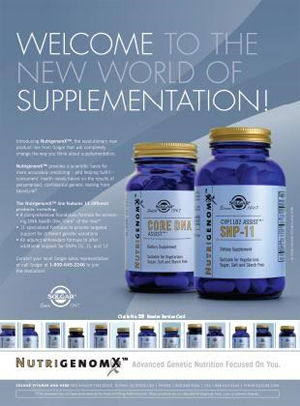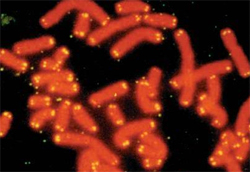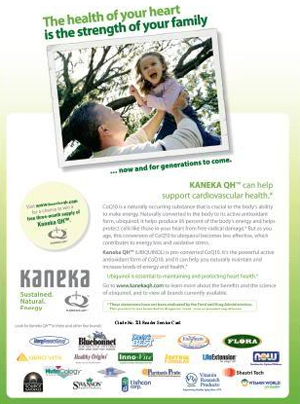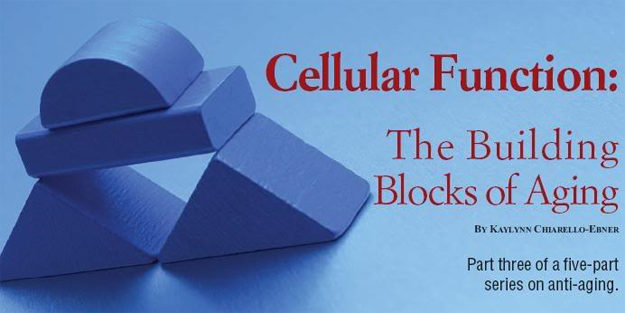Those looking to achieve healthy aging may want to start small. Very small. Microscopically small, in fact, with cellular function. The mechanisms of aging are complex and not completely understood, but cellular health is one aging topic revisited again and again by researchers. Cells are the smallest units of any living organism and have a slew of important functions in the body, not the least of which may be the biology of aging. As we age, say some, cells are used and overused; in turn, our organs (collections of cells) become worn down over time by physical and environmental stresses.
“When looking at something as small as the cells, which are both specialized and general, it is very easy to run into the problem of not being able to see the forest for the trees,” says Val Anderson, vice president and director of sales and marketing at Mineral Resources International, Inc., Ogden, UT. “If the cells are healthy the body is healthy. If the cells are sick the body will be sick…functioning of the cells is just as complex as the functioning of the body as a whole.”
Researchers say if cells have all the nutrients they need for proper function, they will make up the healthy organs and body systems required for healthy aging.
Extinguishing Free Radicals
One aspect of cellular health that has grabbed the public’s attention is oxidative damage caused by free radicals. As we metabolize food for energy, our bodies naturally produce these molecules to kill germs, signal specific mechanisms, induce apoptosis (cell death) and perform other critical functions. “Every time we take a breath of air to sustain our lives, we are generating an increase in the oxidative burden on our body…reactive oxygen species (ROS) is the number one free radical source in our body,” says Chris D. Meletis, N.D., for Trace Minerals Research, Ogden, UT.
 But during times of stress, their production can get out of control—which can harm us. “Excessive free-radical activity leads to attacks on our cell membranes and to an excess of metabolic waste resulting from cellular destruction,” explains James Gormley, associate director of communications for Solgar Vitamin and Herb, Leonia, NJ. Over time, such damage may lead to certain age-associated diseases such as cancer, Parkinson’s and Alzheimer’s, according to the American Federation for Aging Research (AFAR). “Some researchers have even suggested that this damage may be a central cause of the aging process itself,” says the group (1).
But during times of stress, their production can get out of control—which can harm us. “Excessive free-radical activity leads to attacks on our cell membranes and to an excess of metabolic waste resulting from cellular destruction,” explains James Gormley, associate director of communications for Solgar Vitamin and Herb, Leonia, NJ. Over time, such damage may lead to certain age-associated diseases such as cancer, Parkinson’s and Alzheimer’s, according to the American Federation for Aging Research (AFAR). “Some researchers have even suggested that this damage may be a central cause of the aging process itself,” says the group (1).
Free radicals are actually unpaired electrons from atoms that are “cruising around aggressively looking for a partner,” say nutrition writers Jack Challem and Liz Brown (2). If the electrons steal an electron from a healthy cell, it becomes damaged. “Because their electron was stolen, the cells that were once healthy with paired electrons have now been converted to dangerous free radicals in a continuous chain reaction of critical—and in some cases irreversible—cellular destruction,” says Kevin Negrete, president of NuScience Corporation (maker of Cellfood), Lancaster, CA. “Like iron, our body rusts from the inside-out [from oxidative damage]. You may not physically see the rust yet, but you probably are already experiencing some of the more common symptoms like fatigue, slower mental function, muscle or joint pain, inflammation and weight gain.”
Challem and Brown equate the situation to falling dominoes, as one free radical creates another and another “until the cascade of free radicals is quenched by an antioxidant vitamin.” Antioxidants come to the rescue by sacrificing one of their own electrons to the free radical. This neutralizes its reactivity with other cells and stops excess free radical production in its tracks.
Research conducted by Richard Passwater, Ph.D., Solgar’s director of research and development, indicates that by stopping free radical damage in this manner, antioxidants help slow the aging process and support overall wellness. “I was the first to show that practical dosages and combinations of antioxidant nutrients had a positive influence on increasing lifespan (Chemical & Engineering News 1970),” he says. Other research from Passwater on this topic was published in American Laboratory and International Laboratory in 1971.
Some biochemical actions of antioxidants, says Passwater, are:
- stopping free radicals, thereby protecting cell membranes and DNA,
- enhancing immune function,
- binding to skin proteins, collagen and elastin to protect tissue and to seal leaky capillaries,
- improving blood vessels function, from arteries to capillaries, and
- inhibiting tiny blood cells from clotting, which causes circulation problems.
Overall, say John St. Cyr, M.D., Ph.D., medical director, and Jim Herrick, R.Ph., MSc., FASHP, vice president of business development at Bioenergy Life Science, Inc., Minneapolis, MN, most fruits and vegetables are good sources of antioxidants. Those who eat a lot of these foods “have a lower risk of heart disease and some neurological diseases and there is evidence that some types of vegetables and fruits probably protect against a number of cancers,” they say.
But, Negrete points out most people don’t eat enough vegetables and fruits to achieve the established normal biological antioxidant potential (BAP) range of healthy individuals (2,200–4,000 µMol/L). “Most individuals however will find their BAP count in the less-than-optimal <2,000 µMol/L,” he says. “It’s actually possible to be in the sub-optimal BAP range even if you are consuming the suggested amounts of fruits and vegetables,” Negrete adds, because of depleted nutrients in our soil and, in turn, our foods.
To combat this, careful supplementation with antioxidants such as vitmain C, vitamin E, alpha lipoic acid and coenzyme Q10 (CoQ10), says Gormley, should be considered.
Robert J. Barry, Ph.D., scientific affairs, research and new product development for Kaneka Nutrients, L.P., Pasadena, TX, explains that CoQ10, in particular, “plays an essential role as a powerful lipid-soluble antioxidant preventing oxidation of membrane lipids, protein and DNA. Q10 also regenerates cellular stores of vitamin E and vitamin C.”
Antioxidants aren’t the only nutrients running the free radical show. Current research shows that low magnesium levels in the body can “magnify free radical damage” and “hasten the production of free radicals,” says Carolyn Dean, M.D., N.D. (3). She also notes that “cells grown without magnesium were twice as susceptible to free radical damage as were cells grown in normal amounts of magnesium” in studies.
Underscoring the importance of minerals in this area, Anderson adds that the original research to determine which nutrients were and weren’t antioxidants was done by causing oxidative stress to rats—through a magnesium deficiency.
Maintaining Telomere Length
Every time our cells divide, our DNA (i.e., sequences that hold the plans for our genetic makeup) is copied and passed on to new cells. Telomeres cap the ends of our DNA and help protect our genetic blueprints. These structures may also be the hourglasses of our cells; they shrink with each cellular division, thus imposing a finite lifespan on normal (non-cancerous) cells and overall aging. Conversely, according to St. Cyr and Herrick, other cells are immortal (like some cancer cells) because they maintain their telomeres’ lengths.
 Some research indicates that there is a relationship between nutrition and telomere length. For example, a 2007 study showed the link between vitamin D and those with abnormally short telomeres in their white blood cells. Such individuals often have chronic inflammation and related autoimmune diseases like rheumatoid arthritis and other aging-related diseases. In the study, some 2,160 women were examined for factors related to age-related diseases and factors considered to affect the length of telomeres in white blood cells. Overall, say the researchers, “Our findings suggest that higher vitamin D concentrations, which are easily modifiable through nutritional supplementation, are associated with longer LTL, which underscores the potentially beneficial effects of this hormone on aging and age-related diseases” (4).
Some research indicates that there is a relationship between nutrition and telomere length. For example, a 2007 study showed the link between vitamin D and those with abnormally short telomeres in their white blood cells. Such individuals often have chronic inflammation and related autoimmune diseases like rheumatoid arthritis and other aging-related diseases. In the study, some 2,160 women were examined for factors related to age-related diseases and factors considered to affect the length of telomeres in white blood cells. Overall, say the researchers, “Our findings suggest that higher vitamin D concentrations, which are easily modifiable through nutritional supplementation, are associated with longer LTL, which underscores the potentially beneficial effects of this hormone on aging and age-related diseases” (4).
Meletis adds that trans-resveratrol may “help support the guardian gene within the body and has been proposed to support telomere length.”
Balancing Act
Keeping electrolytes in proper balance is another important facet of cellular health. For example, if the sodium outside cells is imbalanced with the potassium inside cells, the body must work hard to keep the minerals in place. “This is actually one of the most common nutrient imbalances in the modern world,” Anderson explains, because we tend to consume more sodium than potassium. “This causes sodium to rush into the cells and the body has to work to get the sodium out. A hundred years ago the average person consumed twice the potassium compared with sodium and significantly more magnesium than sodium. Those ratios have completely reversed in the modern diet due to deficiencies in the soil and the common consumption of processed foods.”
Magnesium is critical in this balance because it helps pump sodium out and potassium into cells. The consequences of this imbalance are serious. According to Mildred S. Seelig, M.D., M.Ph., if potassium doesn’t enter the cell and there’s too much in the blood, there’s a risk of arrhythmia. In addition, low magnesium levels can cause a host of problems including blood clotting in the vessels, excess adrenaline secretion, over-production of cholesterol, increased production of LDL cholesterol and improper glucose processing (5). A proper balance of magnesium, sodium and potassium, Seelig also explains, can have a significant effect on blood pressure and other health conditions.
DNA Damage and Replication
Nearly every second, our DNA gets damaged by environmental toxins or normal metabolic processes. Luckily, says AFAR, our bodies have sophisticated DNA repair systems in place. “Over time, however, our DNA repair systems falter,” the group notes, which could be a major contributor to aging.
St. Cyr and Herrick agree and note, “This damage without repair can severely affect the cell’s intended function and survival.” Backing up this statement, they explain that animals with DNA repair deficiencies tend to have shorter lives and a greater likelihood of developing cancer in studies. “Obviously, if the level of DNA damage exceeds the cell’s capacity to repair the damage, the accumulated errors can overwhelm the cell, resulting in premature aging, apoptosis, or cancer,” they say.
But there’s some hope, says Gormley. “Anti-aging medicine tells us that we can delay the inevitable self-destruct ‘time bomb’ by nutritionally supporting the basic building blocks of DNA within our cells and by preventing damage to, and improving repair of DNA itself,” he explains.
 For example, genistein (from soy) and indole-3-carinol (I3C, from vegetables like broccoli and cabbage) may help boost DNA repair, according to Georgetown University Medical Center researchers. In a 2006 article from the British Journal of Cancer, the team notes that these substances can increase BRCA1 and BRCA2 levels, which help fix damaged DNA. To prove it, breast and prostate cancer cells were exposed to 13C and genistein, which reseachers discovered boosted the production of BRCA1 and BRCA2 (a repair protein). An official Georgetown press release noted, “mutations in either of these genes can lead to development of breast, prostate and ovarian cancers.” Decreased quanities of the BRCA proteins are common in cancer cells, so the researchers suggest that higher levels boosted by I3C and genistein might have protective effects against cancer (6).
For example, genistein (from soy) and indole-3-carinol (I3C, from vegetables like broccoli and cabbage) may help boost DNA repair, according to Georgetown University Medical Center researchers. In a 2006 article from the British Journal of Cancer, the team notes that these substances can increase BRCA1 and BRCA2 levels, which help fix damaged DNA. To prove it, breast and prostate cancer cells were exposed to 13C and genistein, which reseachers discovered boosted the production of BRCA1 and BRCA2 (a repair protein). An official Georgetown press release noted, “mutations in either of these genes can lead to development of breast, prostate and ovarian cancers.” Decreased quanities of the BRCA proteins are common in cancer cells, so the researchers suggest that higher levels boosted by I3C and genistein might have protective effects against cancer (6).
Antioxidants also are said to help protect DNA integrity, says Passwater, who also explains that “complete protection is not possible, so we must rely on protecting DNA as well as we can and then on our body’s ability to repair much of the damage that occurs to DNA.”
Another substance that may help is Unicaria tomentosa extract (tradenamed AC-11). Passwater notes it “seems to have the ability to enhance DNA repair by stimulating the body’s synthesis of DNA repair enzymes.”
St. Cyr and Herrick add “Ribose, a key component in ATP, RNA, and other cellular processes, and deoxyribose in DNA is an essential nutrient” for “maintaining cellular homeostasis and preserving integrity and function.”
Not everyone is convinced that there's a link between nutrition and DNA repair. Some feel that prevention through nutrition is a better avenue to walk. Says Meletis, “Without sufficient B12, DNA production is gravely compromised. And with the high amount of people using acid blockers that drop B12 absorption, this interaction certainly will increase the risk of premature aging.”
A separate, but related, topic to DNA repair is replication. Cellular replication and the passing on of DNA is a normal part of the cell lifecycle, but tumors can form when cells multiply in an unceasing, uncontrolled way. Natural therapies do not claim to cure cancer, prevent the disease or shrink tumors, and those diagnosed with cancer must carefully follow the treatment regimen suggested by their healthcare provider. But, it should be noted that numerous research groups are investigating whether nutrition has any affect on cancer cells. For example, Aleksandra Niedzwiecki, Ph.D., FACN, CEO and director of research at Dr. Rath Research Institute BV, Santa Clara, CA, says that her organization has published more than 30 peer-reviewed articles on the topic. Niedzwiecki notes that work published in Leukemia Research (2005) and PNAS (2005) was on high, intravenous dose of vitamin C and on high doses of EGCG in synergy with other complementary nutrients.
Other research has focused on a fermented wheat germ extract (Avemar, from American Biosciences), testing on those with breast, head, neck, lung and other cancers. The raw ingredient’s inventor, Mate Hidvegi, noted in a presentation delivered in May 2008 that the product may affect glucose metabolism (used by cancer cells to grow) and PARP production (which cancer cells use to repair their DNA damage). And, it may help NK cells recognize cancer cells for attack. New research on patients with high-risk skin melanoma who used the supplement is due to be published in a top cancer biotherapeutics journal later this year.
Replenishing Cellular Energy
Experts suspect that dwindling cellular energy may be another culprit in aging, particularly with respect to the mitochondria. These structures convert nutrients to cellular energy, but become less efficient over time, which makes cells unable to function. In fact, according to AFAR, older individuals tend to have less efficient mitochondria than younger people.
According to St. Cyr and Herrick, though, dietary supplements can help support mitochondrial metabolism. For example, they protect the mitochondria from free radical damage, supply essential nutrients and enhance electron transport efficiency.
Select Product OfferingsAmerican Biosciences is the maker of Avemar, fermented wheat germ supplement. Bioenergy Life Science, Inc., offers several ribose products under the Corvalen name. Dr. Rath Research Institute BV offers Epican Forte (contains vitamin C, lysine, proline, arginine, N-acetyl-cysteine, EGCG from green tea, selenium and other micronutrients); Enercor (contains l-cartinine, CoQ10, vitamin C, B-vitamins, vitamin C, magnesium, taurine); Vitacor Plus, Arteriforte (synergy of 30 vitamins, minerals, amino acids and other natural components); Metavicor and Vitacor Plus (contains B-vitamins, carnitine, betaine, vitamin C and other components. Kaneka Nutrients supplies co-enzyme Q10 (KanekaQ10) and is the manufacturer of KanekaQH. LifeVantage produces Protandim, a blend of phytonutrients that stimulates SOD and CAT production. These enzymes induce a cascade of natural catalytic antioxidants that are "able to destroy millions of free radicals per second, on a continuous basis," according to the company. Lonza is the supplier of Carnipure, a special grade of l-carnitine. Mineral Resources International offers Lifestyle Dosing (adds essential nutrients to foods and beverages), FortiSalt (added to food, provides a high level of magnesium and most essential trace minerals), Anderson's Concentrated Mineral Drops (rich in magnesium and other minerals), Omnimin (rich in magnesium and other minerals), Elete (liquid electrolyte add-in) and Chi Health Solute Ions (helps cleanse cells and provides nutrients that cells need). NuScience Corporation makes Cellfood (contains 78 ionic/colloidal trace elements and minerals, 34 enzymes, 17 amino acids and dissolved oxygen suspended in a solution of deuterium sulfate. Solgar Vitamin and Herb makes several products in this category including, AC-11, PEAK ATP, CoQ10, gPLC, Acetyl-l-camtine and more. In addition, Solgar's NutrigenomX line includes AC-11 in its Core DNA Assist Blend, which can be found in every NutrigenomX product. Trace Minerals Research is the manufacturer of CoQ10 (liquid and capsule forms), Greens Pak, Greens 4 Health, Mega-Mag, Ionic Magnesium and ConcenTrace. |
Two nutrients that may support mitochondrial health are l-carnitine and lipoic acid. L-carnitine is an amino acid that helps shuttle long-chain fatty acids into the mitochondria, where they are used for energy and to produce ATP. A carnitine deficiency, says AFAR, “leads to an inability to harvest the energy stored in fatty acids and to a build-up of fatty intermediates that can prove toxic to cells.”
According to Passwater, “Supplementation with advanced carnitines such as gPLC and acetyl-l- carnitine for a few weeks can also help restore membrane potential, oxygen utilization and cardiolipin. However, it does not lower the level of oxidants, oxidized RNA or lipid peroxidation products. These can be lowered by supplementation with the antioxidant alpha lipoic acid.”
In addition, co-enzyme Q10 (CoQ10), which drops with age along with its conversion to ubiquinol, also is critical for energy production. “This decline in cellular Q10 has been associated with aging and age-related disease such as the varied forms of cardiovascular, neurodegenerative, diabetes as well as the decrease in energy and stamina commonly experienced with the aging process,” says Barry.
He explains that CoQ10 “plays a well-established role in cellular energy production as a critical co-enzyme in mitochondrial ATP (energy) production. Q10 is absolutely essential for cellular energy production.”
St. Cyr and Herrick explain that ribose also is helpful to the mitochondria. Not only does it help control the levels of oxygen free radicals formed under stress, but it also helps with the re-synthesis of ATP. This, they say, may help in healthy aging Baby Boomers who are experiencing prolonged fatigue.
ATP, according to a Solgar consumer brochure, stores energy used to carry out cellular function. Our bodies’ stores of ATP dwindle with age and stress. This decline is said to be linked with a “loss in wellness and vitality, reduced nutrient absorption, slower cellular and tissue regeneration, less efficient organ function, memory loss, lean muscle loss and reduced circulation to the peripheries.” Thus, supplementation with ATP is often recommended along with other nutrients that assist in the recovery of ATP such as ribose.
Healthy cells use glucose and oxygen to make ATP. Stress signals (like debris from a cell that dies) often stimulate a neighboring cell to act in a certain way such as switching on a non-oxidative pathway. This explains the aging process, says David Wales, president of American Biosciences, Blauvelt, NY. “The longer the intermediate compounds linger it creates a stress signal, which is the formula for aging,” he notes.
Sometimes, in the process of the switch, “the cell gets stuck in the non-oxidative pathway until it potentially becomes damaged,” says Wales. A fermented wheat germ product (Avemar from American Biosciences) may be useful on this front. In vitro studies on the supplement indicate that it can modulate metabolism and “help cells respond appropriately to stress signals,” he notes. Thus, cells often switch back to the oxidative pathway and produce ATP at a steady rate.
Another key energy component is magnesium, which is essential for numerous enzyme reactions and every form of energy conversion and use within the body, says Anderson. In addition, “The majority of ATP in the body is actually bound to magnesium and magnesium is essential for ATP to become active energy,” he explains and adds that the mineral is essential for insulin production as well as insulin uptake. Unfortunately, soil is depleted of the mineral—and in turn our vegetables—so supplementation is a good way to restore magnesium in the body. WF
References
- American Federation for Aging Research, www.infoaging.org.
- J. Challem and L. Brown, User’s Guide to Vitamins & Minerals (Basic Health Publications, North Bergen, NJ, 2002).
- C. Dean, The Magnesium Miracle (Ballantine Books, New York, NY, 2007).
- J.B. Richards, “Higher Serum Vitamin D Concentrations Are Associated with Longer Leukocyte Telomere Length in Women,” Amer. J. Clin. Nutr. 86 (5), 1420–1425 (2007).
- M.S. Seelig, The Magnesium Factor (Avery, New York, NY 2003).
- Georgetown University Medical Center, “Veggies Contain Chemicals That Boost DNA Repair And Protect Against Cancer,” (2006).
Published by WholeFoods Magazine, August 2008.










